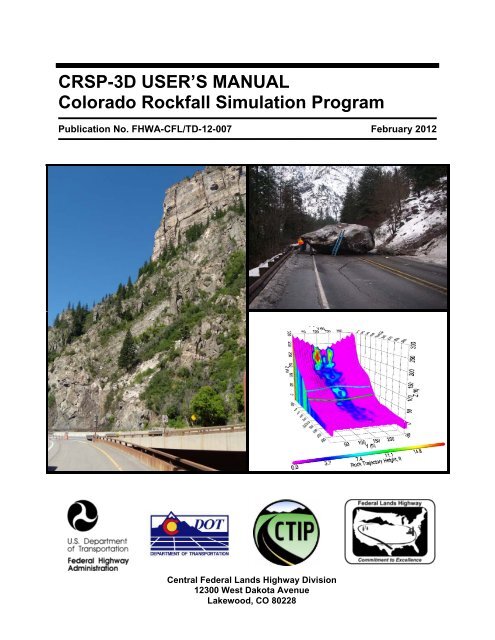- Colorado Rockfall Simulation Program (CRSP) analysis was performed to correlate the range of velocities and energies expected from a typical Ohio rockfall with the energy of 40 to 60 kJ that is targeted for the impact tests conducted in this task.
- The Colorado Rockfall Simulation Program (CRSP) was developed to provide a statistical analysis of probable rockfall behavior at any given site and to be used as a tool to study the behavior of rockfalls, to determine the need for rockfall mitigation, and to aid in the design of rockfall mitigation.
- Problem Solving Software
- Colorado Rockfall Simulation Program Version 5
- Colorado Rockfall Simulation Program Manual
- Colorado Rockfall Simulation Program 3d

The Colorado Rockfall Simulation Program (CRSP) was developed in 1987 to estimate the velocity, energy, and bounce heights of rockfall, which in turn forms a basis for selection of designs for mitigation. Several revisions were issued in the following years, and the program has been widely used for rockfall. How is Colorado Rock-Fall Simulation Program (Colorado Department of Transportation) abbreviated? CRSP stands for Colorado Rock-Fall Simulation Program (Colorado Department of Transportation). CRSP is defined as Colorado Rock-Fall Simulation Program (Colorado Department of Transportation) rarely. Providing the popular Colorado Rockfall Simulation Program computer software Providing comment and guidance for proposed rockfall mitigation Providing educational resources so that the people of Colorado our many visitors might better understand rockfall and the risk associated with living in and traveling through mountainous terrain.
$0.00
The Colorado Rockfall Simulation Program (CRSP) was developed to model rockfall behavior and provide a statistical analysis of probable rockfall events at any given site. Version 4.0 is used for Windows 95, 98, and NT systems and includes: introduction, previous work and background, methods, results, discussion of results, conclusions, recommendations, use of the CRSP program, references, appendix. 61 figures. 8 tables. Digital ZIP download. 127 pages. MI-66D
Tips for working with Windows 7:
1. When installing try right clicking and choosing “Run as Administrator”
2. When using the installed .exe, right click on the .exe and choose “properties”, then choose the “Compatibility” tab, then click the tabs “Run this program in compatibility mode for: Windows XP (Service Pack 3)”, and also choose the “Run this program as an Administrator”. You should only have to do this once and from then on you will only need to double click on the CRSP icon.
Aside from these suggestions we offer no further support, which is why we are now making it free. We realize that while this is still a useful program, it’s reaching the end of its Windows operating system life-cycle.
Problem Solving Software
2000s, CGS, download, free, hazards, MI-, publication, rockfall, software, statewide, zip
Jones, Christopher L., Jerry D. Higgins, and Richard D. Andrew. “MI-66 Colorado Rockfall Simulation Program, Version 4.0.” Rockfall Simulation Program. Miscellaneous MI-66. Denver, CO: Colorado Geological Survey, Division of Minerals and Geology, Department of Natural Resources, March 2000. https://coloradogeologicalsurvey.org/publications/colorado-rockfall-simulation-program.
The Colorado Rockfall Simulation Program (CRSP) was developed to provide a statistical analysis of probable rockfall behavior at any given site and to be used as a tool to study the behavior of rockfalls, to determine the need for rockfall mitigation, and to aid in the design of rockfall mitigation. The basic theory behind CRSP is summarized, and the results of recent program modifications and calibration are discussed. CRSP uses numerical input values assigned to slope and rock properties to model rockfall behavior. The model applies equations of gravitational acceleration and conservation of energy to describe the motion of the rock. Empirically derived functions relating velocity, friction, and material properties are used to model the dynamic interaction of the rock and slope. The statistical variation among rockfalls is modeled by randomly varying the angle at which a rock impacts the slope within limits set by rock size and slope irregularities. The program provides estimates of probable velocity and bounce height at various locations on a slope. Experimental verification and calibration of CRSP was conducted by analyzing videotapes of rocks traveling down a slope. A comparison of rock velocity and bounce height obtained from the tapes with CRSP prediction indicates reasonable agreement. Also, an evalution of the sensitivity of input parameters indicates that slope angle and surface roughness are the most important parameters on steep slopes. Design graphs are developed based on CRSP simulations by using surface roughness and slope angle to estimate rock velocity and bounce height on uniform slopes.
- Record URL:
- http://onlinepubs.trb.org/Onlinepubs/trr/1990/1288/1288-014.pdf
- Record URL:
- https://scholar.google.com/scholar_lookup?title=ROCKFALL+HAZARD+ANALYSIS+USING+THE+COLORADO+ROCKFALL+SIMULATION+PROGRAM&author=T.+Pfeiffer&author=J.+Higgins&publication_year=1990
- Availability:
- Find a library where document is available. Order URL: http://worldcat.org/isbn/0309050642
- Supplemental Notes:
- This paper appears in Transportation Research Record No. 1288, Geotechnical Engineering 1990. Distribution, posting, or copying of this PDF is strictly prohibited without written permission of the Transportation Research Board of the National Academy of Sciences. Unless otherwise indicated, all materials in this PDF are copyrighted by the National Academy of Sciences. Copyright © National Academy of Sciences. All rights reserved
- Authors:
- Pfeiffer, Timothy J
- Higgins, Jerry D
- Publication Date: 1990
Media Info

- Features: Figures; Photos; References; Tables;
- Pagination: p. 117-126
- Monograph Title: Geotechnical engineering 1990 - soils, geology and foundations
- Serial:
- Issue Number: 1288
- Publisher: Transportation Research Board
- ISSN: 0361-1981
Colorado Rockfall Simulation Program Version 5
Subject/Index Terms
- TRT Terms: Acceleration (Mechanics); Angularity; Calibration; Design; Dynamics; Elasticity (Mechanics); Energy conservation; Equations; Forecasting; Friction; Gravitation; Hazards; Impact; Properties of materials; Rock mechanics; Rockfalls; Roughness; Simulation; Slopes; Statistical analysis; Traffic mitigation; Velocity; Videotapes
- Uncontrolled Terms: Bounce; Impact angle; Mitigation; Verification
- Old TRIS Terms: Angles, geometry; Gravitational acceleration
- Subject Areas: Data and Information Technology; Design; Energy; Environment; Geotechnology; Highways; Materials; I43: Rock Mechanics;
Colorado Rockfall Simulation Program Manual
Filing Info
Colorado Rockfall Simulation Program 3d
- Accession Number: 00607757
- Record Type: Publication
- ISBN: 0309050642
- Files: TRIS, TRB, ATRI
- Created Date: Apr 30 1991 12:00AM
